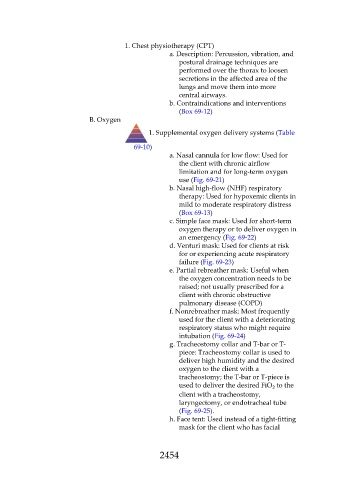Page 2454 - Saunders Comprehensive Review For NCLEX-RN
P. 2454
1. Chest physiotherapy (CPT)
a. Description: Percussion, vibration, and
postural drainage techniques are
performed over the thorax to loosen
secretions in the affected area of the
lungs and move them into more
central airways.
b. Contraindications and interventions
(Box 69-12)
B. Oxygen
1. Supplemental oxygen delivery systems (Table
69-10)
a. Nasal cannula for low flow: Used for
the client with chronic airflow
limitation and for long-term oxygen
use (Fig. 69-21)
b. Nasal high-flow (NHF) respiratory
therapy: Used for hypoxemic clients in
mild to moderate respiratory distress
(Box 69-13)
c. Simple face mask: Used for short-term
oxygen therapy or to deliver oxygen in
an emergency (Fig. 69-22)
d. Venturi mask: Used for clients at risk
for or experiencing acute respiratory
failure (Fig. 69-23)
e. Partial rebreather mask: Useful when
the oxygen concentration needs to be
raised; not usually prescribed for a
client with chronic obstructive
pulmonary disease (COPD)
f. Nonrebreather mask: Most frequently
used for the client with a deteriorating
respiratory status who might require
intubation (Fig. 69-24)
g. Tracheostomy collar and T-bar or T-
piece: Tracheostomy collar is used to
deliver high humidity and the desired
oxygen to the client with a
tracheostomy; the T-bar or T-piece is
used to deliver the desired FiO to the
2
client with a tracheostomy,
laryngectomy, or endotracheal tube
(Fig. 69-25).
h. Face tent: Used instead of a tight-fitting
mask for the client who has facial
2454

